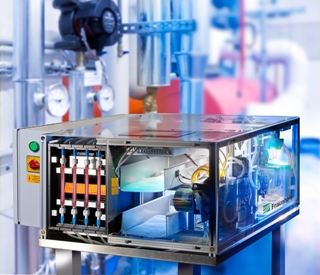Jan 5 2016
We place high demands on the quality of our drinking water. If pathogens or toxic substances found their way into the piping system, many people could become infected or injured very quickly.
 Online monitoring of water supply pipes: The biological broadband sensor AquaBioTox reacts immediately to toxic substances in water. (Credit: © Photo: Fraunhofer IOSB)
Online monitoring of water supply pipes: The biological broadband sensor AquaBioTox reacts immediately to toxic substances in water. (Credit: © Photo: Fraunhofer IOSB)
That’s why this risk must be kept low. To do this, experts have developed technologies for a comprehensive monitoring, early warning and emergency management system.
Drinking water is indispensable for every human being. Public works and water utilities must not only protect the supply system from impurities, but also from possible manipulation. Every day, they collect probes and analyze drinking water quality in a lab, but such analysis takes time. Preventative methods and tools are needed for continuous monitoring in order to identify contaminations quickly and also catch unexpected toxic substances. Even a few drops could have devastating consequences – toxins that make their way into the water supply reach millions of users within hours. “In order to protect the population, we have to be able to detect the hazardous substances as quickly as possible and know how they will spread,” explains Dr. Thomas Bernard, a specialist for flow models at Fraunhofer Institute for Optronics, System Technology and Image Exploitation IOSB in Karlsruhe. In collaboration with partners from industry and research, the scientist and his team from the French-German project SMaRT-OnlineWDN (Online Security Management and Reliability Toolkit for Water Distribution Networks) have developed tools that enable water utilities to respond quickly and, in an emergency, to initiate countermeasures to protect the population. The project was supported by the German Federal Ministry of Education and Research (BMBF) and the French National Research Agency (ANR). Berlin’s water utility, BWB Berliner Wasserbetriebe, coordinated the project.
Online simulation calculates water’s path
A mathematical model for simulating the drinking water supply network hydraulics and the distribution of quality parameters in the piping systems carries out several tasks simultaneously. Based on numerous simulations, it can identify the optimum locations for sensors in order to ensure early detection of impurities. Furthermore, if an alarm does go off, the online simulation model can help pinpoint the source of the contamination. The scientists have developed an algorithm for this that localizes the contamination and calculates where the impurity will spread in the next few hours. But calculating and predicting the water’s path – and thus the path of the toxic substance – was no easy task, even for Bernard, because the flow of water in the supply network is not identical everywhere. “It changes depending on the pressure in the pipes, their diameter and geometry, and the number of users. And turbulence and chaotic flows occur in places where the pipe system branches.”
Tests at the Water Technology Center TZW in Dresden, where a complex pipe network has been built out of Plexiglas, have helped Bernard and his French partners establish an intelligent detection module. At the center in Dresden, sensors register the water’s movement. Using the measurement values, the physicist was able to optimize his computer simulations. The aim is to calculate the flow of the water in the supply networks of entire cities – in real time. “Such simulations could assist utility companies in making the right decisions in emergencies, but only when they are precise and fast enough,” says the group leader.
Alarm only in emergencies
Intelligent software takes current measurement values into account, such as opacity, temperature, pressure, chlorine and oxygen content, pH value and the amount of bacterial contamination of the water. But when critical values are reached, the system doesn’t immediately sound the alarm – instead, it first looks for possible causes. Has a different water source just been tapped? Was a pump opened or closed? “More than 90 percent of all anomalies are caused by changes to operating conditions and are no cause for alarm,” explains Bernard.
The new system has already been implemented in Strasburg and monitors the network’s water quality in real time. Hydraulic and water quality sensors in the pipe network deliver information for the database; the collected data is then sent to a process control system. In case of emergency, countermeasures can be initiated, such as flushing contaminated water or blocking off parts of the supply network.
Control through monitoring platform
Future models will be able to do even more: In the German-French ResiWater project (see box), IOSB scientists are working on better IT security for drinking water systems and on an improved module for generating alarms. Along with Strasburg, Paris’s drinking water system will be monitored in the future. Furthermore, the project partners are focusing on a monitoring platform that takes the myriad of sensor data and clearly represents, visualizes, and stores it. It will also automatically generate reports so that, for instance, fluctuations in water quality can be regularly summarized.
The ResiWater project partners are also driving sensor development. For example, the Fraunhofer Institute for Interfacial Engineering and Biotechnology IGB in Stuttgart is contributing its know-how. For many years, they have been working on AquaBioTox, a biosensor made from living cells that fluoresce. When bacteria come in contact with toxic substances, the intensity of the fluorescence decreases. The AquaBioTox prototype will be fully automated as part of the ResiWater project.